
Lexus Australia recently offered what it says is a glimpse into the future of safer urban mobility with a cooperative ITS (C-ITS) demonstration in Darling Habour, Sydney.
The company is collaborating with ITS Australia, Queensland state government’s department of transport and main roads, plus key industry partners, to showcase a new way for vehicles to protect vulnerable road users (VRUs). These include pedestrians, riders, young children and the elderly, all of whom are disproportionately represented in the Australian road toll. Of the 1,106 road fatalities in 2020, 12% were pedestrians, 17% motorcycle riders and 4% cyclists.
Lexus Australia said that it and its partners are advancing urban mobility by prioritising safety and inclusivity, aiming to create a safer, more efficient, productive, sustainable and accessible transport system.
Lexus also said that its partners are not limited to vehicle manufacturers and governments but represent a broader push from all parts of the engineering world to deliver safer systems for our communities.
Commsignia is a Vehicle to Everything (V2X) provider for infrastructure, automotive and vulnerable road users. Bosch Security & Safety Systems Australia provides deep-learning video-based detection cameras. HMI Technologies specialises in roadway management. Meanwhile, Aptella is a specialist in intelligent automation, positioning and mapping technologies.
For the demonstrations, attendees experienced - from the comfort of a new-release Lexus retrofitted with cutting-edge C-ITS technology - how "Cooperative Awareness" and "Collective Perception" can enable real-time information sharing between "connected" and "non-connected" road users. This can enhance driver awareness and safety for riders and pedestrians.
For the demonstrations – part of the recent ITS Australia Summit - the stages of C-ITS development were broken down into "days" according to system capabilities. Day one was about shared awareness. Vehicles and infrastructure can share and receive information about themselves.
Day two was about shared perception. Vehicles and infrastructure can collect and share and receive information about their surroundings.
Day three was concerned with shared intention where vehicles and infrastructure coordinate their behaviour.
Attendees learned how C-ITS can reduce crashes at intersections using cooperative awareness, how it can protect cyclists with ultra-lightweight DSRC (dedicated short-range communications) systems, how it can predict pedestrian movements with integrated camera analytics and avoid collisions using collective perception as well as how it can digitally manage road space with intelligent traffic alerts.
Lexus said its initiative aligns with Australia's National Road Transport Technology Strategy and sets a global benchmark, demonstrating how cooperative and automated transport technologies can enhance social, environmental and economic well-being. "Lexus globally strives for mobility with zero fatalities and injuries from traffic accidents,” said John Pappas, chief executive of Lexus Australia.
“Cooperative intelligent transport systems have a significant role to play in achieving this target. We are proud to assist with pioneering trials in Australia, where Lexus vehicles exchange safety messages with infrastructures and vehicles,” said Pappas. “Importantly, working with stakeholders enables us to explore the best technologies for Australian conditions.”
"This project demonstrates how existing technology can improve safety for road users,” said Susan Harris, chief executive of ITS Australia. She noted that there was work to do to explore how its deployment can be accelerated to bring forward safety benefits across the country's transport network.










